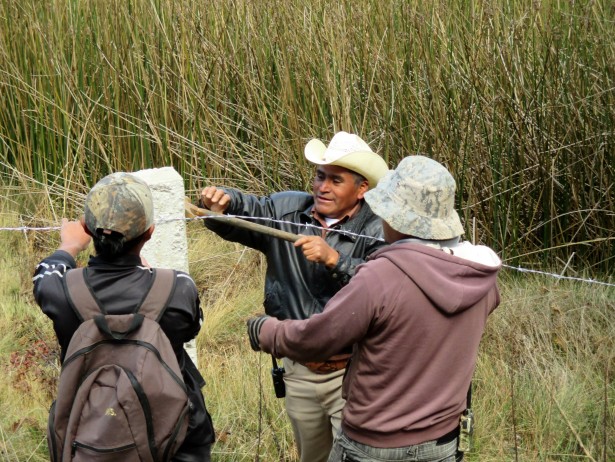
by Deep Green Resistance News Service | Feb 28, 2016 | Biodiversity & Habitat Destruction, Indirect Action
Featured image: Candelaria residents erect a fence around the Suyul Lagoon to help protect it from intruders. (Waging Nonviolence/Sandra Cuffe)
By Sandra Cuffe / Waging Nonviolence
The reeds and grasses are as tall as Sebastián Pérez Méndez, if not taller. The vegetation is so thick it’s hard to see the water in the Suyul Lagoon that he and other local Maya Tzotzil residents are working hard to protect. Pérez Méndez crosses the road to point out where aquatic plants serve as a natural filter for the water as it flows out the lagoon, located in the highlands of Chiapas, in southern Mexico.
“The water is under threat,” he said. Pérez Méndez is the top authority of the Candelaria ejido, a tract of communally-held land in the municipality of San Cristóbal de las Casas. “We’re not going to allow it.”
Communities in Chiapas are organizing to protect the Suyul Lagoon and communal lands from a planned multi-lane highway between the city of San Cristóbal de las Casas and Palenque, where Mayan ruins are a popular tourist destination. Candelaria residents continue to take action locally to protect the lagoon. They also traveled from community to community along the proposed highway route, forming a united movement opposing the project.
It all started back in 2014 when government officials showed up in Candelaria looking for ejido authorities, including Pérez Méndez’ predecessor. It was the first residents had heard about plans for the highway. The indigenous inhabitants had not been consulted and were not shown detailed plans.
“They realized that [the government officials] were only seeking signatures,” Pérez Méndez said.
No one person or group is authorized to make a decision that would affect ejido lands, however, and there are strict conditions in place to ensure elected ejido leaders are accountable to members, he explained. An extraordinary assembly was held to discuss the highway project.
The Candelaria ejido was established in 1935, a year after a new agrarian law enacted during the Lázaro Cárdenas administration led to widespread land reform throughout Mexico. More than 2,000 people live in the 1,600-hectare ejido, and more than 800 of them are ejidatarios — legally recognized communal land holders whose rights have been passed down for generations. Only ejidatarios as a whole have the power to make decisions on issues like the highway project.
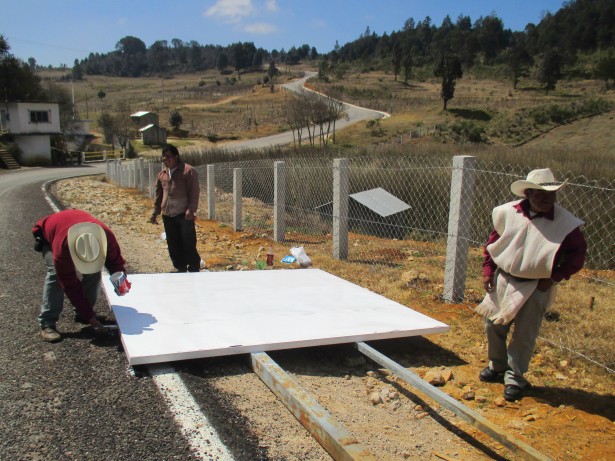
Candelaria residents paint over graffiti to fix up a roadside sign proclaiming their opposition to the highway project. (Waging Nonviolence/Sandra Cuffe)
“The ejido said no,” said Guadalupe Moshan, who works for the Fray Bartolomé de Las Casas Human Rights Center, or FrayBa, supporting Candelaria and other communities in Chiapas. “They didn’t sign.”
Candelaria leaders sought assistance from FrayBa in 2014, after they were approached by government officials and pressured to sign a document indicating their consent to the highway project that would involve a 60-meter-wide easement through communally-held lands. Officials told community members that the highway was already approved and that they would be well compensated, but that there would consequences if they refused to sign, Moshan said.
“They told them they would suspend government programs and services,” she explained. In the days following the extraordinary ejido assembly rejecting the project, there was unusual activity in the area, according to Moshan. Helicopters flew over theejido, unknown individuals entered at night, and trees were marked, she said.
Protecting the Suyul Lagoon remains at the heart of Candelaria’s opposition to the planned highway. The lagoon provides potable water not only for Candelaria, but also for several nearby communities, said ejido council secretary Juan Octavio Gómez. Aside from the highway itself, project plans eventually shown to the community leaders include a proposed eco-tourism complex right next to the lagoon. That isn’t in the communities’ interest, Gómez explained.
“Water is life. We can’t live without it,” he said. “Without this lagoon, we don’t have another option for water.”
Fed by a natural spring, the Suyul Lagoon never runs dry. Local residents are careful to protect the water and lands in the ejido, where the majority of residents live from subsistence agriculture, sheep rearing and carpentry. They engage in community reforestation, but have plans to plant more trees, Gómez said.
The Suyul Lagoon is also sacred to local Maya Tzotzil. Ceremonies held every three years in its honor involve rituals, offerings, music and dance.
“It is said that it’s the navel of Mother Earth,” Pérez Méndez said.
Candelaria residents didn’t sit back and relax after rejecting the highway project in their extraordinary assembly. They have been organizing ever since. The Suyul Lagoon lies just outside the Candelaria ejido, but it belongs to ejidatarios by way of an agreement with the supportive land owner. Aside from the highway project and potential eco-tourism complex, the lagoon has caught the attention of companies, whose representatives have turned up in the area expressing interest in establishing a bottling plant.
It’s cold in February up in the highlands, but community members have been out all day, erecting a fence around the Suyul Lagoon to protect it from intruders. White fence posts are visible under the treeline across the sea of reeds. Like so many other local initiatives, fence materials are collectively financed by the ejido and the labor is all voluntary, communal work.
While residents continue stringing barbed wire from post to post, others take paintbrushes to one of their roadside signs. Locals have erected large signs next to roads in and around their ejido, announcing their opposition to the tourist highway.
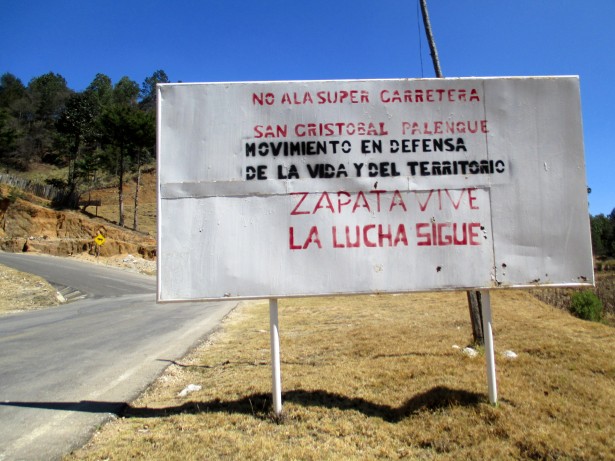
A sign along the road leading to Candelaria informs passers-by of opposition to the planned super-highway. (Waging Nonviolence/Sandra Cuffe)
“We’re also already organized with the other communities,” Pérez Méndez said. “All the communities reject the super-highway.”
After they were approached by government officials, Candelaria ejido residents traveled from community to community along the entire planned highway route. Some communities hadn’t heard of the project at all, while others said they were pressured into signing documents indicating their consent, Pérez Méndez said. As a result of Candelaria’s visits, community organizing along the highway route led to the formation of a united front of opposition, the Movement in Defense of Life and Territory.
Candelaria also recently got together with other indigenous communities in the highlands to issue a joint statement rejecting the tourist super-highway and a host of other government and corporate projects and policies.
“Our ancestors, our grandfathers and our grandmothers have always taken care of these blessed lands, and now it’s our turn to [not only take] care of the lands, but also to defend them,” reads the February 10 communiqué.
“The neoliberal capitalist system, in its ambition to exploit natural assets, invades our lands,” the statement continues. “The government and transnational companies are violently imposing their mega-projects.”
Back along the edge of the Suyul Lagoon, Candelaria residents continue to string barbed wire from post to post. They’ve been at it for a while now, according to Pérez Méndez, but they’ve now stepped up their efforts and hope to finish the fence by the end of the month.
Pérez Méndez surveys the progress, protected from the unrelenting sun and icy wind by his hat and white sheep’s wool tunic. He becomes pensive when asked if he thinks communities will be able to defeat the highway project.
“Yes,” the ejido leader said, after giving it some thought. “We can stop it.”

by Deep Green Resistance News Service | Feb 18, 2016 | Biodiversity & Habitat Destruction
By Deep Green Resistance
Wild Bison are an icon of what has been destroyed by civilization, and this species is now on the brink in the wild. Almost all bison left today are cross-breeds held in confinement. There are only a few wild, free ranging bison herds left on the planet, and their numbers are small. Every year, the Park Service — at the behest of ranchers — round up, quarantine, harass, and kill many of the wild bison who live in and around Yellowstone National Park. We stand with grassroots land defenders such as the Buffalo Field Campaign in calling for an immediate end to this atrocious treatment of wild bison. Instead of quarantine, these creatures need room to roam. Instead of harassment, they need our assistance in growing once again to their historical numbers.

From Buffalo Field Campaign:
Yellowstone National Park has released an Environmental Assessment (EA) for a fifty-year quarantine program which seriously threatens America’s last wild, migratory bison population. Unfortunately there is very little in this EA for bison advocates to support, as even the “no action” alternative maintains the Park’s ongoing capture-for-slaughter program. Comments are due by midnight MDT February 29, 2016. (This is a new, extended deadline.)
Quarantine domesticates wild bison, subjects them to artificial selection and commercial management practices and treats them like livestock. Quarantine is an insult to First Nations buffalo cultures with strong cultural, spiritual, and traditional ties to wild, migratory buffalo in and around Yellowstone. Quarantining wild, migratory bison and dooming them to a life behind fences ignores the critical keystone relationship between wild bison and their natural prairie and grassland communities. Migration is one of the buffalo’s strongest, most significant gifts to a healthy landscape. Quarantine reduces buffalo to a domesticated state, and is not appropriate for wildlife. Quarantine, which imposes a state of control and surveillance over wild bison, is the direct result of the livestock industry’s intolerance. Quarantine is a toxic mimic of natural restoration, a program in which humans manipulate the wild and free to suit their own selfish agendas. Quarantine does not end slaughter, it begins with it, ripping buffalo families apart and orphaning calves who spend the rest of their lives behind fences.
Yellowstone’s ongoing capture-for-slaughter and fifty-year quarantine plan will result in extremely adverse cumulative impacts, and we need to force the agency to seriously and honestly review the best available scientific information in a comprehensive Environmental Impact Statement (EIS).
Recent history has already shown that quarantine does not work for wild bison. The Quarantine Feasibility Study that began in 2005 resulted in wild Yellowstone buffalo being commercially owned for profit, while some of the buffalo who went to Ft. Peck died in a horrible fire because they could not escape their enclosure, and half of the herd that was transferred to Ft. Belknap died because they could not escape their enclosure to find fresh water. Wild bison do not belong behind fences, they are a nation unto themselves who evolved to migrate, wild and free!
TAKE ACTION! Please use the sample letter below only as an example, and in your own words, address the adverse impacts of quarantining wild bison and the Park’s ongoing capture for slaughter mismanagement scheme. Don’t allow Yellowstone National Park to domesticate wild, migratory bison!
HOW TO SEND YOUR COMMENTS: Respondents are encouraged to submit their comments online through the Planning, Environment and Public Comment (PEPC) website at www.parkplanning.nps.gov/BisonQuarantine. Comments may also be hand-delivered to the park administration building, or mailed to: Superintendent, Yellowstone National Park, Wyoming, 82190. Comments will NOT be accepted by fax, e-mail, or in any manner other than those specified above.
SAMPLE LETTER – Please edit with your own remarks! See above for instructions on how to submit your comments. Due by February 29, 2016.
Superintendent Dan Wenk
Yellowstone National Park
Attn: Bison Quarantine EA
P.O. Box 168
Yellowstone National Park, Wyoming 82190
RE: Comments on Yellowstone Bison Quarantine Program EA
Dear Superintendent Wenk,
Thank you for the opportunity to comment on Yellowstone’s quarantine environmental assessment (EA). I am strongly opposed to Yellowstone’s proposed fifty-year quarantine plan as well as the Park’s ongoing capture-for slaughter operations. As an advocate for wild, migratory bison, I find it impossible to support quarantine in Yellowstone or elsewhere, or your no-action alternative to continue capturing wild buffalo for slaughter.
Yellowstone’s proposed fifty-year quarantine plan, as well as the Park’s ongoing capture-for-slaughter operations have significant cumulative negative impacts, which requires your agency to seriously and thoroughly review the best available information in a comprehensive Environmental Impact Statement.
The U.S. Congress never intended for wild buffalo in Yellowstone to be declared “surplus” and did not authorize the Secretary of the Interior to remove wild buffalo as “surplus” for quarantine. By regulation, Yellowstone National Park is prohibited from removing “surplus” wild buffalo from the population in Yellowstone “when the animals are to be slaughtered, or are to be released without adequate protection from premature hunting.” 36 C.F.R. § 10.3(d) (2015).
Yellowstone’s fifty-year quarantine program is in direct violation of the Organic Act and National Park Service policies, as it includes capturing wild bison for quarantine with potential recipients including agricultural or commercial producers, reducing ecologically extinct wild bison to livestock.
Wild bison are further adversely impacted by Yellowstone’s proposed quarantine plan and ongoing capture-for-slaughter operations, which aim to reduce America’s last continuously wild herds to a mere 3,000 animals, and maintain this low population, making wild bison extremely vulnerable by threatening their natural immunity to introduced diseases from cattle and elsewhere, including brucellosis. Such poor management practices increase the risk of wild bison becoming more vulnerable to various diseases as strains become more virulent and persistent. Further, the population target of 3,000 is based on livestock industry politics and lacks scientific or ecological basis.
In recent history, Yellowstone’s participation in the state-federal Quarantine Feasibility Study resulted in the commercialization and privatization of wild bison, making a commodity of our nation’s valued wildlife. It resulted in the domestication of wild bison originating from Yellowstone. All of the wild bison who survived the quarantine feasibility study have been reduced to private livestock or meat behind fences, many of which died throughout the process, through transport to other quarantine facilities, or who suffered horrible deaths by fire and dehydration as a result of their confinement.
The recent quarantine program has been a failure. There is no indication that quarantine with the costly, restrictive, and burdensome requirements of the U.S. Department of Agriculture will in any way lead to the recovery of ecologically extinct wild bison as a wildlife species anywhere in the country. Quarantine domesticates. It harms and degrades the wild integrity of America’s last wild bison population and subjects wild bison to commercial management practices and artificial selection.
Indigenous people of North America have held strong cultural and spiritual ties to wild, migratory buffalo for tens of millennia. Some of these relationships are so deep that the people consider the buffalo to be actual relatives. “Offering” indigenous buffalo cultures the return of their relatives through quarantine and capture-for-slaughter can be viewed as a continuation of the U.S. government’s assimilation program, which aims to make cattle out of wild, migratory bison, and livestock producers out of traditionally nomadic indigenous buffalo cultures.
Ongoing capture-for-slaughter operations and the proposed quarantine program are a violation of the treaty rights held by more than twenty-five sovereign, indigenous nations. The harmful programs of hazing, quarantine, and slaughter prevent wild, migratory bison from restoring themselves on their native landscape, including open and unclaimed public lands. These nation-to-nation treaties, which the federal government has a legal obligation to honor, hold that these indigenous cultures have a sovereign right to hunt, gather, and hold ceremony on open and unclaimed lands. Sadly, wild, migratory bison are absent and unavailable on many of these lands due to these bison management practices.
Yellowstone’s fifty-year quarantine plan further harms wild, migratory bison because quarantine has adverse impacts on herd dynamics, social structure, and collective wisdom handed down through generations. Quarantine negatively modifies wild bison behavior in ways that are unnatural and harmful, including continuing pressures of domestication, conditioning to human manipulation, and artificial selection — all tools for managing livestock, not wildlife. Wild, migratory bison are able to take care of themselves, with no cost or need of interference from humans. Wild bison are able to create and manage their own habitat, while bison behind fences invoke restrictive, costly, and burdensome requirements by the U.S. Department of Agriculture.
Yellowstone National Park’s voluntary agreement to adhere to the highly controversial Interagency Bison Management Plan contradicts the mission of the National Park Service. The Park Service and other IBMP member agencies fail to operate using the best available science and information, falling back instead on expired information and misguided assumptions, in direct violation of the Park Service’s mandate.
Nearly 6,000 ecologically extinct, wild, migratory bison have been killed or eliminated from America’s last continuously wild population with direct and indirect participation from Yellowstone National Park, through capture-for-slaughter, quarantine, hazing fatalities, and the surrender of wild bison for scientific experiment. An independent population viability analysis must be conducted (and funded) by Yellowstone National Park to determine how management actions and consequent cumulative impacts threaten the long-term viability, diversity, integrity, and evolutionary potential of wild, migratory bison. It is also required that an impairment review be undertaken to determine the long-term and cumulative impacts of capture-for-slaughter operations and the proposed fifty-year quarantine program.
There is a win-win situation for wild, migratory bison and indigenous buffalo cultures that does not include the mass killing or domestication of wild bison: natural restoration through the simple and ancient natural phenomenon of migration. Migration corridors must be protected and made available to wild bison by federal, state, and public trust land management agencies, working with private landowners and tribal governments. The migration corridors in and around Yellowstone are a first priority, along with the protection of the bison themselves — both of which are denied under current management. When wild bison are protected and allowed to restore themselves throughout their native range, they will naturally return to the lands that are their birthright, lands they have been forcibly and lethally removed from, where indigenous buffalo cultures are ready to welcome them home.
Sincerely,
[Your name]
Read more at Buffalo Field Campaign. Help support BFC here.
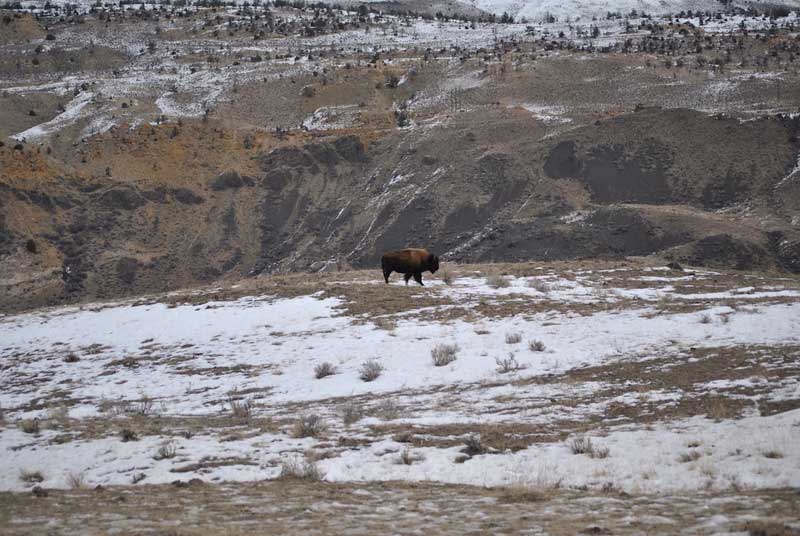
by Deep Green Resistance News Service | Jan 22, 2016 | Biodiversity & Habitat Destruction
By Stephany Seay / Buffalo Field Campaign
Featured image: A young bull buffalo walks the hills in the Gardiner Basin. Photo by Stephany Seay
Based on what we witness in the field everyday, the killing taking place near Gardiner could more accurately be described as a slaughter than a hunt. The tribal game wardens we have spoken with agree, and they recognize that Montana’s livestock interests have organized the circumstances to shift blame away from themselves to the tribes. There is obviously something terribly wrong when every last buffalo to migrate through Beattie Gulch ends up dead, or when hunters feel so desperate to kill every buffalo they see. Whether or not tribal hunters view their hunts as supporting the larger management scheme, the Interagency Bison Management Plan (IBMP) government agencies and affiliated tribal entities certainly do. There is no moral or scientific justification to the idea, perpetuated by the management agencies, of “surplus buffalo” and safeguards allowing buffalo safe passage between Yellowstone and Montana are sorely needed.
We have never and will never stand against treaty rights, but we maintain a steadfast opposition to the current management that uses hunting as a means to eradicate the buffalo. As currently practiced, the hunt is an extermination plan set up by livestock interests to ensure that buffalo never reclaim the lands that are their ancestral home and birthright. It is fundamentally wrong and immoral for hunters to be led to believe that if they don’t kill the buffalo in this way, that they will just be slaughtered anyway.

This little buffalo calf was shot in the leg by hunters at Beattie Gulch. He survived and somehow managed to run off, escaping through nearby private land; but his leg was shattered. A Montana game warden shot him to end his suffering, then with assistance from a Montana Department of Livestock stock inspector and U.S. Forest Service law enforcement officer, he was hauled out from his resting place along the Yellowstone river. As if to reward this unethical hunting behavior, the agents ended up giving him to the hunter who wounded him. Photos by Stephany Seay (above) and Deleana Baker (below), Buffalo Field Campaign.

So long as buffalo die, the livestock industry and the governments don’t care who does the killing or how. Contrast this to the tens of thousands of elk in the region who have been implicated in the transmission of brucellosis, and yet no one is claiming that there are “surplus” elk and no one is targeting them for transmitting disease to cattle. The welfare ranchers don’t want to lose their foothold on control of the grass, so the buffalo, whom they view as competitors, must die. Hunters are in fact serving livestock interests no matter an individual hunter’s intentions.
The buffalo death toll is quickly rising. More than fifty of the country’s last wild buffalo have been killed by hunters since we last wrote. Mid-week, over five-hundred buffalo migrated into Montana, nearly all at once, through Beattie Gulch at Yellowstone’s north boundary. Being in the midst of this ancient phenomenon is at once one of the most beautiful and most heartbreaking experiences. The migration of hundreds of buffalo is such a beautiful sight, a flow that has purpose and integrity, so simple in its power, timeless and perfect, seemingly unstoppable; but this ancient march is also heartbreaking because it leads so many buffalo straight to their deaths.
As we expected, word of this migration spread quickly, and hunters arrived en masse that night, the following day, and through the weekend. We expected a massacre, but through the course of days, the majority of the buffalo threatened to cross various lines, edging towards areas where they could be hunted, only to retreat in the nick of time. Frustrated hunters were driving all over the Basin, even through the Park, following us, glaring at us, wanting to blame us, looking for buffalo that they could kill, but finding few. Those few were gunned down rapidly at the Park boundary, in acts of haste and desperation. Many have been shot and wounded, fleeing into Yellowstone where hunters cannot pursue them, left to die slowly or walk forever with bullets in their flesh.
By Sunday, frustrated and determined to get their buffalo meat, hunters in pick-ups and on foot crowded around the park boundary, watching a family group of about thirty buffalo slowly make their way towards Beattie Gulch. The firefight that ensued that morning ended life for twenty-eight of those buffalo; the eight survivors, two of them shot and wounded, fled up the mountain and away with their lives.
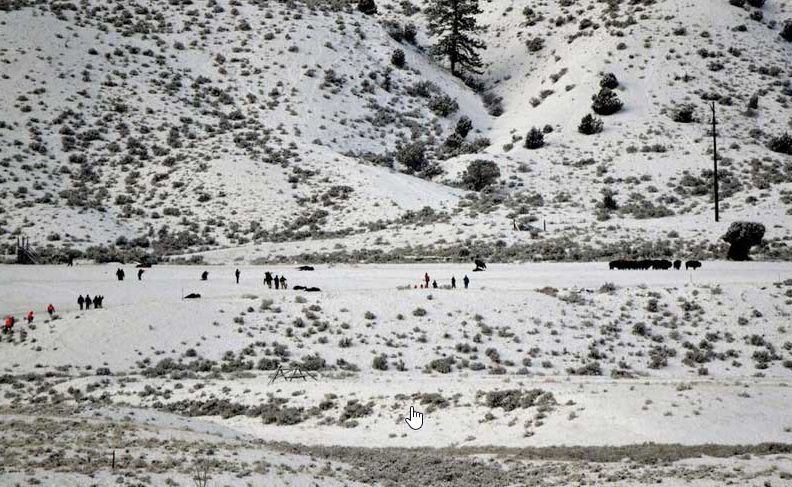
Images from the slaughter at Beattie Gulch, described above. Photos by Deleana Baker, Buffalo Field Campaign.
Make no mistake: BFC fully supports treaty rights and tribal sovereignty, yet our first priority is to the buffalo. What is taking place here is an extermination plan, and hunters are being used. We have to work in solidarity to demonstrate this, to end livestock control, and to get the buffalo — through migration — back on the landscape, in great numbers so that the proper, respectful relationships can be restored. Buffalo will take care of the people, but the people need to take care of them first. They need our help.
This whole Plan — which treaty hunting is certainly a part of from the government’s viewpoint, and all the discussions and decisions that happen within the IBMP — is in place to harm the buffalo and to keep them from restoring themselves across the landscape. We need to put our collective energy into fighting the IBMP and the law that places the Montana Department of Livestock in charge of buffalo in Montana. We must acknowledge that wild buffalo are ecologically extinct, and the IBMP is using hunting as well as slaughter and hazing to facilitate their destruction, to prevent their restoration.
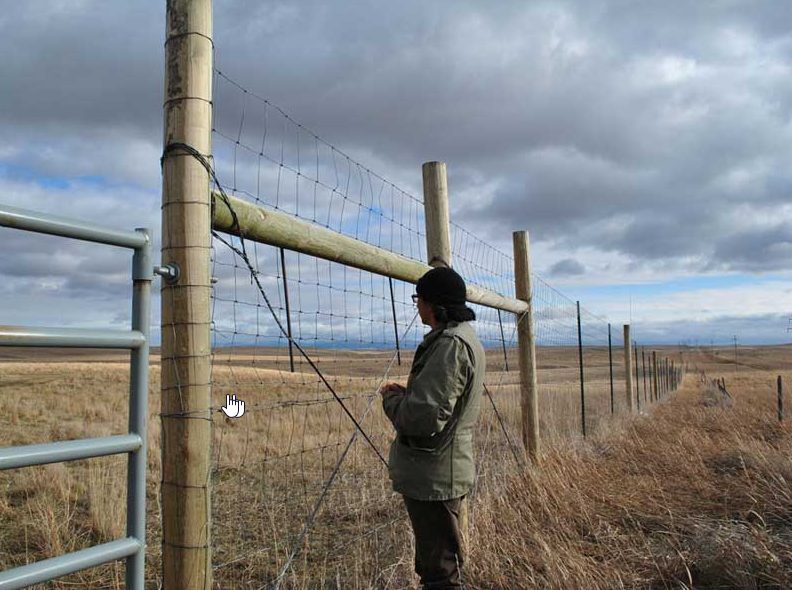
Catcher Cuts the Rope, Gros Ventre (A’aninin), looks into the formidable enclosure where quarantined Yellowstone buffalo now reside on the Ft. Belknap Indian Reservation. Photo by Stephany Seay, Buffalo Field Campaign.
The same can be said of quarantine, which is a management tool for livestock, not wildlife. Again, livestock interests present “choices”: dead buffalo or buffalo behind fences. Yellowstone National Park is aiming to develop a fifty-year plan for operational quarantine, making the process of domesticating wild, migratory buffalo an entrenched aspect of bison management. To be free or caged in is not an option in the wild world, it is a human option. Quarantine is something to satisfy the human; an easy way out, a toxic mimic of true wildlife restoration. It is a means to control what should be free. Quarantine is also part of the brucellosis lie, the premise being that bison pose a brucellosis threat, which we know to be untrue. Should elk be quarantined also? Elk have brucellosis but roam free.
The quarantine process begins with buffalo families being torn apart, adults shipped to slaughter, calves orphaned and raised in domestication. Then, those who survive the human-handling and testing of the quarantine process will live behind fences for the rest of their lives. We have seen the buffalo who suffered “living” in quarantine; they were not happy, they looked to get out of those pens. They were humiliated and afraid. Many of them have died horrible deaths because they could not escape their enclosures. Quarantine is part of the culture of death, this “civilized” system that systematically destroys life on the planet. Quarantine asks us to accept an “easy fix” that will give the human ego gratification.
Migration is free and alive; it is having the ability to make choices, being self-willed. Buffalo behind fences to be food for humans is a view that reduces them to meat. They have strong relationships with more than humans. The compromise should be in standing aside and respecting how a creature places one foot in front of the other — and we fight those things that get in the way of that. Quarantine removes the buffalo from their natural community, from life and their gift to life. Who is asking the buffalo’s perspective, asking them what they want? The buffalo will tell you that migration is they key to restoration. They know the way.
So many feel stuck in the “choices” that the government and industry have put before us. People believe that they are doing the buffalo a “favor” by hunting them, or by supporting quarantine, because otherwise they would be captured and shipped to slaughter. They are shipped to slaughter anyway. Having to pick hunt, quarantine, or slaughter is being forced to make artificial and unnecessary choices. So long as this Plan is in place, so long as Montana is in control, so long as wild buffalo numbers are driven down to serve livestock industry politics, and so long as wild buffalo are prevented from restoring themselves on the landscape, the problems will persist. We must fight this Plan and livestock control in all it’s guises. We must demand an end to livestock control, demand that wild buffalo walk the earth, demand an end to this management scheme.
One industry’s intolerance is driving a national treasure towards the brink of extinction. We must put an end to livestock industry control over wild buffalo, and to do so we must repeal the law — MCA 81-2-120 — that places them in charge. As evidenced by his decision to grant year-round habitat on Horse Butte, Montana Governor Steve Bullock is listening, but the livestock industry is trying to undermine his citizen-supported decision. He must hear from us all, frequently. Please contact Governor Bullock today, even if you have already, thank him for granting year-round habitat on Horse Butte and urge him to help repeal MCA 81-2-120. With endless pressure, endlessly applied, we can end livestock industry control and gain more of the buffalo’s Montana home for them to roam.
Thank you so very much for being with us for wild buffalo!
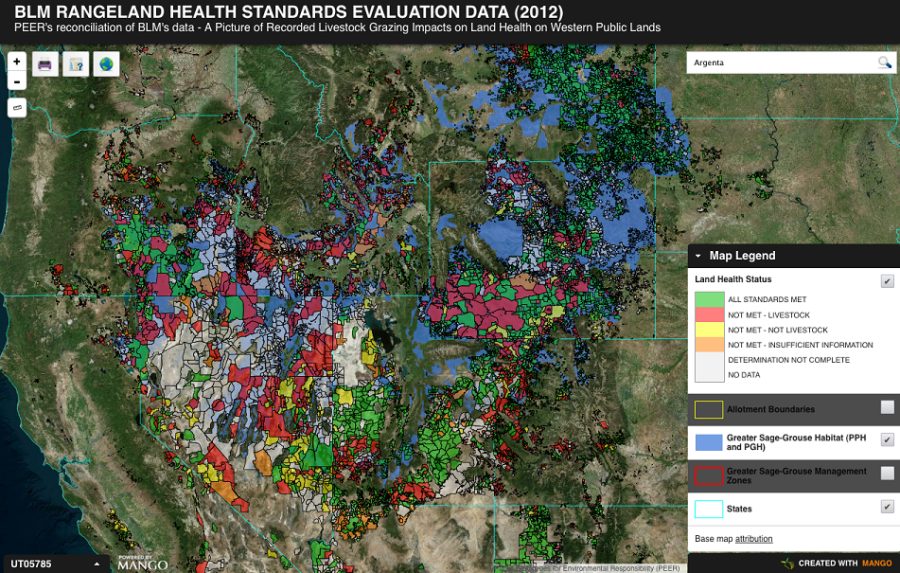
by Deep Green Resistance News Service | Jan 19, 2016 | Biodiversity & Habitat Destruction
Searchable BLM reports and satellite images for 20,000 grazing allotments
Featured image: The map includes blue-tinted areas that represent Greater sage grouse habitat, underneath the tens of thousands of tinted grazing allotments. Image by High Country News.
When the Bureau of Land Management ordered the removal of cattle from public rangeland this summer near Battle Mountain, Nevada, the state was in its third year of severe drought. Conditions were too dry to sustain the number of cattle that were grazing there, the BLM contended. Locals responded in part by announcing a “Cowboy Express” ride from Bodega Bay, California to Washington, DC to protest federal overreach and to demand that local District Manager Doug Furtado be ousted.
Disagreements like the one in Battle Mountain are hardly novel in Western politics. But this week, a new tool to understand livestock impact on public lands was thrown into the mix. Washington, DC-based non-profit Public Employees for Environmental Responsibility (PEER) released an interactive map that collates over 45,000 BLM records that diagnose 20,000 allotments. The map is seven years in the making, the result of Freedom of Information Act requests PEER and Western Watersheds Project put to the BLM.
Read more at A new map shows rangeland health West-wide

Damage to the land from livestock can be seen in satellite images. Image by High Country News.

Shaded areas indicate where rangeland has failed to meet BLM health standards between 1997 and 2013. Image by High Country News.

by Deep Green Resistance News Service | Jan 15, 2016 | Biodiversity & Habitat Destruction, Lobbying
Featured image: A bull buffalo lies dead, just outside Yellowstone’s north boundary. Photo by Stephany Seay, Buffalo Field Campaign
On January 12, the U.S. Fish and Wildlife Service (USFWS) denied Endangered Species Act protection for the iconic Yellowstone Bison. The agency’s decision comes 14 months after Western Watersheds Project and Buffalo Field Campaign petitioned to list these bison as an endangered or threatened species. The groups sought federal protection for the Yellowstone bison because these unique bison herds are harmed by inadequate federal and state management and other threats. In the finding, the USFWS now agrees that the Yellowstone bison are a distinct population of bison, reversing its 2011 position.
“If buffalo are to recover as a wild species in their native ecosystem, science must prevail over politics,” said BFC Executive Director Dan Brister. “The best available science indicates a listing under the Endangered Species Act is necessary to ensure the survival of this iconic species.”
“Friends of Animals is committed to protecting the last wild bison in America. We are disappointed in USFWS’s finding and suspect that the decision was improperly influenced by the interests of private ranchers in the area. We are reviewing the agency’s decision and plan to take further legal action if necessary,” stated attorney Michael Harris of Friends of Animals Wildlife Law Program.
“We petitioned the USFWS to list the Yellowstone bison because of clear management inadequacies and growing threats to this key population of wild bison. The USFWS decision is disappointing because protection under the Endangered Species Act is the only way to counter the management inadequacies and growing threats,” stated Michael Connor of Western Watersheds Project.
The groups’ petition catalogues the many threats that Yellowstone bison face. Specific threats include: extirpation from their range to facilitate livestock grazing, livestock diseases and disease management practices by the government, overutilization, trapping for slaughter, hunting, ecological and genomic extinction due to inadequate management, and climate change.
Federal and state policies and management practices threaten rather than protect the Yellowstone bison and their habitat. Since 2000, more than 4,000 bison have been captured from their native habitat in Yellowstone National Park and slaughtered. The Forest Service issues livestock grazing permits in bison habitat. The states of Montana, Idaho, and Wyoming forcefully remove or kill bison migrating beyond the National Park borders.
Once numbering tens of millions, there were fewer than 25 wild bison remaining in the remote interior of Pelican Valley in Yellowstone National Park at the turn of the 20th Century. The 1894 Lacey Act, the first federal law specifically safeguarding bison, prevented the extinction of these few survivors.
The agency’s justification can be found online at:
http://buffalofieldcampaign.org/ESA_90_Day_Finding.pdf
The petition to list Yellowstone bison is available online at http://www.buffalofieldcampaign.org/ESAPetition20141113.pdf
Visit Buffalo Field Campaign for field updates
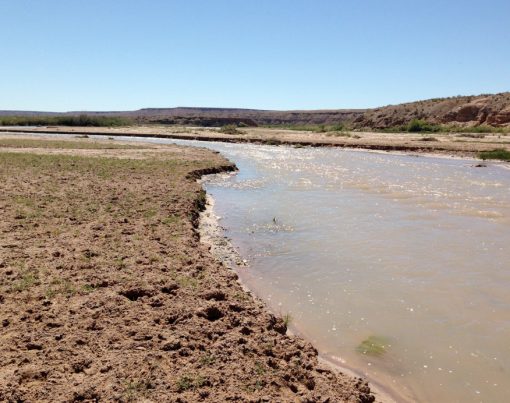
by Deep Green Resistance News Service | Jan 11, 2016 | Biodiversity & Habitat Destruction
By Katie Fite / WildLands Defense
This article first appeared on Counterpunch
Featured Image: Virgin River with banks trampled like a feedlot by Cliven Bundy cattle. May 2015.
In Oregon, an armed occupation of Malheur Wildlife Refuge headquarters is being led by self-proclaimed “patriots” from Nevada. They are defending a public lands ranching family’s “right” to set fires and break the law.
In Nevada, Cliven Bundy owes more than a million dollars in grazing fees. An armed confrontation broke out when BLM began to impound his trespass livestock. The government backed down. For almost two years, no action has been taken while the Bundy camp becomes ever more brazen. This past summer, when Cliven Bundy went to the Nevada legislature to support a bill to turn over federal authority of public land to the state, he was treated to a barbecue by Nevada Congressman Mark Amodei.
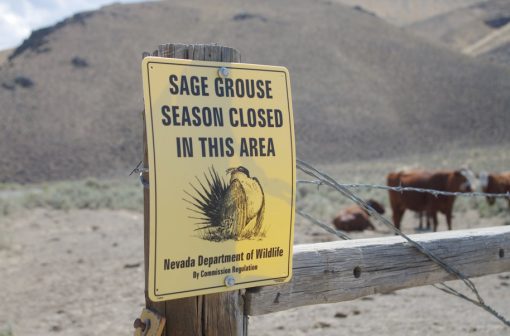
Cliven Bundy is not the only Nevada Rancher being given proprietary treatment by Nevada federal land managers. Settlement deals and BLM coddling reward hostile ranchers at the expense of the public’s land.
Argenta Allotment Settlement
There has been prolonged, severe drought in Nevada. In 2014, defiant public lands ranchers resisted Battle Mountain BLM drought closures and cattle cuts in the Argenta allotment. They were emboldened by the Bundy incident. The ranchers set up a “Grass Camp,” aided by instigator Grant Gerber, across from the BLM office. They have waged an intimidation campaign against agency staff. They whined incessantly to cattle friendly Nevada politicians Amodei and Senator Heller. The Elko paper did not really report, but instead was a worshipful cheerleader against the BLM. The ranchers denied there even was a drought. At the very same time, they received lavish federal drought disaster relief payments.
The cattle damage became so severe that by late summer the local BLM finally closed the sensitive sage-grouse habitats in mountain pastures of the Shoshone Range to grazing. The ranchers and states rights politician John Carpenter appealed the protective closure. In spring 2015, an Interior Department Office of Hearings and Appeals administrative law judge finished review of a mountain of documents, and ruled in favor of the closure.
But within weeks, BLM folded. All of Argenta was again flung open to grazing. Leadership under Nevada BLM Director John Ruhs had forced a settlement deal indulging the ranchers’ every whim. Ruhs, bonded at the hip with the Cattlemen, had been “Acting” Director, and then officially became Nevada Director.

Nevada BLM Director John Ruhs
The deal was greased through by the “National Riparian Team,” composed of livestock industry sycophants from within BLM and the Forest Service, and outside cattle consultants.
The Team, while claiming to be a neutral party, immediately took the ranchers’ side – with Team members railing against perceived interference by the local BLM staff that had sought to control cattle damage to the public lands. So it’s no surprise the settlement flung open sensitive closed sage-grouse habitats to full bore grazing. Herds of several hundred cows were allowed to trample and devour “forage” across the drought-stricken public land in 2015.
The settlement put the Team in charge of a Coordinated Monitoring Group “(CMG”) dominated by ranchers and a token enviro group to take control of monitoring, to direct management actions, and run interference with the local BLM so the Argenta ranchers would not be accountable for grazing damage or trespass.
The cabal bars the public and press from observing their monitoring of grazing damage, and from their closed door discussions that dictate management. The group tells BLM what to do to keep the ranchers happy.
The result has been grazing chaos, and wanton damage of lands and waters. Wildlands Defense (WLD) and colleagues visited Argenta to observe and document conditions. Cattle were scattered all over the allotment, and riparian areas ravaged. When we asked BLM where cows were supposed to be present, the local BLM managers did not even know. All was in the hands of the Team and CMG.
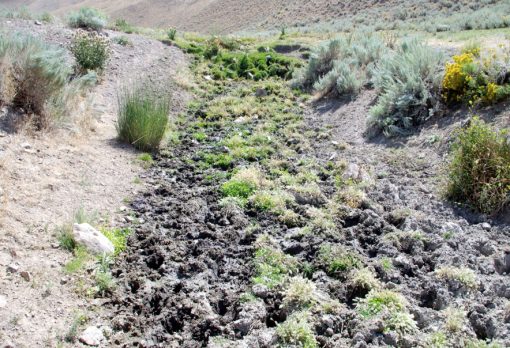
Cattle trampling dries out and destroys sage-grouse brood habitats.
Scads of new cattle projects are also laid out in the settlement. A July Team memo plans new barbed wire fencing and water projects incrementally sprawled across Argenta. The Team embraces injurious grazing practices – severe cattle trampling soil disturbance and high use of native grasses. Why the projects? So ranchers don’t have to work to control their cows. This frontloads Argenta with band-aid fences around prominent degraded areas (and long term monitoring sites) close to roads, prior to any thorough Land Health assessment. There never has been any grazing study since the 1976 passage of FLPMA. The ranchers can then claim conditions within the little fenced areas are “improving,” and insulate against cattle cuts in an assessment.
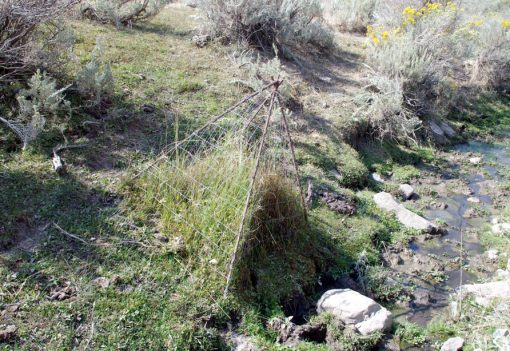
Monitoring cage illustrating how severe cattle use is. Our site visits found such cages destroyed in some areas since the CMG group took over.
This fall, BLM obediently issued a Decision giving the ranchers six new permanent fences, plus “temporary” water troughs and a pipeline. WLD and Wild Horse Education appealed the first battery of projects, which are terrible for wildlife. Sage-grouse and other wildlife are killed by flying into or becoming entangled with wire. The projects also shift intensive impacts onto other areas. We also challenged the Ruhs Settlement – which has altered grazing, established the exclusive closed meetings, and directed the projects. BLM claims we can’t appeal the Settlement.
Now over the holidays, BLM proposed more projects. The ranchers, through the cover of the Team and CMG, are essentially now running the public lands.
North Buffalo Settlement
Days after BLM caved in Argenta, one of the very same permittees, Filippini Ranch, rewarded BLM appeasement efforts by unleashing their cattle on the nearby North Buffalo allotment. North Buffalo, like Argenta, was closed for drought protection. It is home to a very small struggling population of sage-grouse, whose habitat is also being consumed by foreign gold mines.
BLM could not help but notice the cows turned out illegally, since the ranch owner told about the trespass to the Elko newspaper, flaunting his power. Leadership under Ruhs promptly rewarded this trespass with another Settlement deal. Just as in Argenta, a North Buffalo Settlement flung open the closed lands. BLM charged Filippini around $100 for willful trespass – a small price for being allowed access to tens of thousands of dollars worth of public lands “forage” for which the permittees pay a pittance.
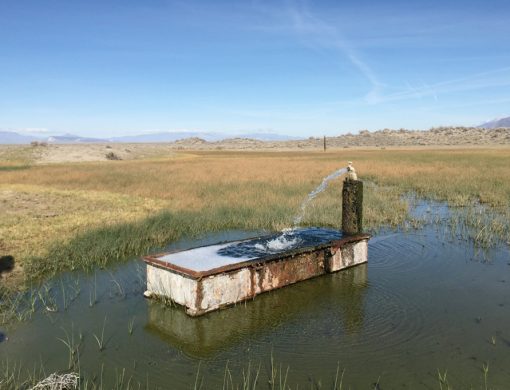
Uncapped abandoned test well site in now Wilderness lands where rancher claimed water rights.
DeLong and Humboldt County Settlement
There is yet another Settlement deal gift to a powerful rancher, this time in Winnemucca BLM lands. The powerful Delong ranching operation and Humboldt County had sued BLM over a raft of access issues primarily involving cattle water projects, many in Wilderness areas with no access roads. The projects had not been recognized by BLM when compiling project lists following the passage of the Black Rock Wilderness legislation in 2000. The lawsuit involved arcane regulations originating in the 1800s and early 1900s. BLM issued a scoping letter this fall proposing to maintain, reconstruct and access 15 cattle projects, access private inholdings, and maintain irrigation ditches – mainly in the North Jackson, South Jackson and Black Rock Wilderness in the South Jackson allotment.
BLM did not tell the public in its confusing letter that the proposal was based on yet another recent Settlement deal. We only learned of this when querying the BLM staff.
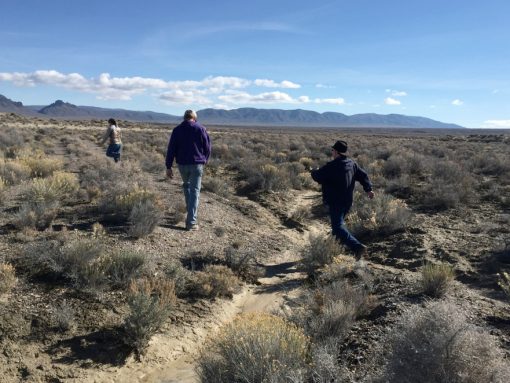
BLM field trip in area where rancher is being allowed access for cattle water project.
Hold Your Wild Horses
BLM leadership has knowingly looked away from a series of purposeful and blatant violations of the Code of Federal Regulations by a rancher (Borba) in the Fish Creek wild horse Herd Management Area in Battle Mountain country.
The rancher was found to be in “willful trespass,” grazing his livestock outside the boundaries of his legally authorized use for eight months. Under pressure from politicians Heller and Amodei, the BLM reduced the trespass and lowered fees.
The rancher and Eureka County also became upset over a local BLM decision to manage wild horses to incrementally reduce the population. The BLM removed over 200 wild horses, and then planned to use the PZP fertility control drug, and release horses given fertility control back to the HMA. In a stand-off reminiscent of an old western movie, the county and rancher showed up onsite and demanded the BLM not release the horses.
The BLM caved, and the horses were hauled away. After a lengthy legal battle the horses were returned to the range months later.
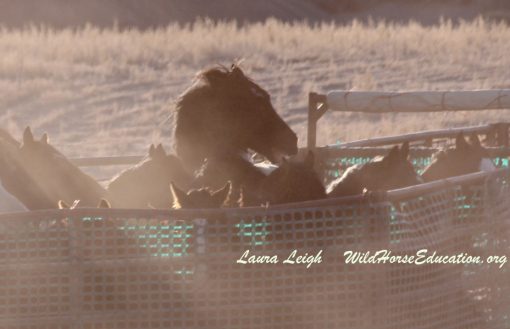
The disgruntled rancher began a social media campaign to rile the public against “government abuse.” Claims were made that he was never in trespass. He videotaped himself repeatedly breaking the law, and put it on social media. The penalties for the acts committed clearly state that the permittee will face fines, possible jail time and “shall” lose the right to graze on public lands.
Ruhs met with the rancher, County and local BLM Manager Furtado at Fish Creek, and sided with cattleman over his own staff. The BLM state office has now put the brakes on the fertility control program for the Fish Creek wild horses. This winter, the permittee is grazing livestock as if nothing happened.
Is It Continued Bungling, Political Interference or Tacit Support?
Badly bungling the Bundy situation and failing to act for almost two years now, the BLM opened the floodgates of rancher defiance and Sagebrush Rebel hell. The Ruhs Settlement deals reward powerful public lands ranchers who hate the agency and the very concept of public good and public lands. Allowing violations of federal law to go unaddressed has created an environment where any concept of law appears meaningless. The Settlements in Argenta, North Buffalo, Jackson Mountain/DeLong, coupled with BLM leadership ignoring blatant Fish Creek rancher law-breaking, embolden the very parties who want to see the public lands become unmanageable by the federal government.
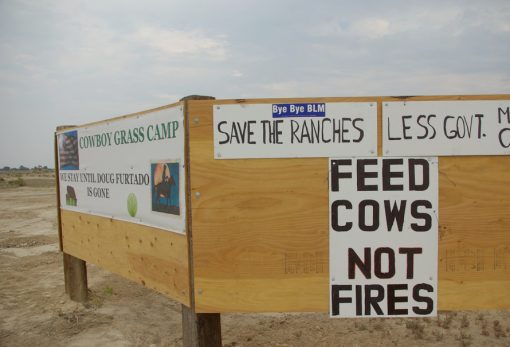
Safety of BLM employees on the ground has been jeopardized. The ranchers want removed anyone who might attempt to protect the environment. Their intimidation campaign is demanding Battle Mountain District Manager Doug Furtado be fired. The local office has been rendered powerless.
Appointment of Ruhs as Nevada Director, sweetheart settlement deals and toleration of overt law-breaking all have taken place under national BLM Director Neil Kornze, a native of Elko, Nevada and son of a mining engineer.
Is this ineptitude on the part of BLM leadership, political interference, or something else? Kornze increasingly appears to be either the most bungling BLM Director ever – or a fellow traveler with the Nevada public Land Grab crowd. While we continue to see PR photos of the BLM Director on outdoor excursions, important areas of the American West are being handed over to the welfare ranchers through a policy of capitulation and appeasement – resulting in a de facto loss of federal control and stealth Land Grab.























